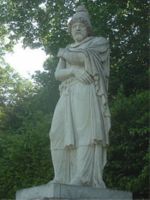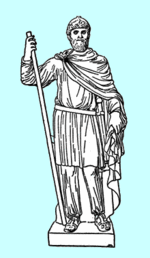Tiridates I of Armenia
2007 Schools Wikipedia Selection. Related subjects: General history; Historical figures
Tiridates I ( Armenian: Տրդատ I, Trdat I), was king of Armenia from 53 AD with a brief interruption towards the end of the year 54 and a much longer one from 58 to 62. He was the founder of the Armenian line of the Arsacid Dynasty known as the Arshakuni Dynasty, although not the first Arsacid on the Armenian throne.
Ascension
In 53 Roman governor of Cappadocia, Paelignus, invaded Armenia and ravaged the country, then under an Iberian usurper King Radamisto. Syrian governor Quadratus sent a force to repair these outrages; but he was recalled so as not to provoke a war with Parthia. King Vologases I of Parthia took the opportunity and invaded Armenia, conquering Artaxata and proclaiming his brother Tiridates as king. A winter epidemic forced him to withdraw his troops from Armenia, allowing Radamisto to come back and punish locals as traitors; who eventually revolted and replaced him with the Parthian prince Tiridates in early 55. Radamisto escaped along with his wife Zenobia. Zenobia, was captured but Tiridates treated her like a royal queen. Radamisto himself returned to Iberia and was soon put to death by his father Parasmanes I of Iberia for having plotted against the royal power.
War with Rome
Unhappy with the growing Parthian influence at their doorstep, Roman Emperor Nero sent General Corbulo with a large army to the east in order to restore Roman client Kings. A Hasmonean named Aristobul was given Lesser Armenia (Nicopolis and Satala), Sohaemus of the house of Emessa received Armenia Sophene. In the spring of 58 Corbulo entered into Greater Armenia from Capadoccia and advanced towards Artaxata, while Parasmanes I of Iberia attacked from the north, and Antiochus IV of Commagene attacked from the southwest. Tiridates ran away from the capital and Corbulo burned Artaxata to the ground. In the summer Corbulo began moving towards Tigranocerta, through a very rough terrain, passing through the Taronitida (Taron) where several of his commanders died in an ambush by the Armenian resistance, however they arrived to the city that opened its doors, except one citadel that resisted, and was destroyed in the ensuing assault. By this time the majority of Armenians had abandoned resistance and accepted the prince given by Rome. Nero gave the crown to the last royal descendant of the Kings of Capadoccia, the son of Glaphyra (daughter of Archelaus of Cappadocia) and Alexander of Judea, the brother of Herod Archelaus, who assumed the name Tigranes VI, his brother was Tigranes V. Border districts were given to Roman allies that assisted Corbulo. Tigranes invaded the Kingdom of Adiabene in 61, which was a vassal of Parthians. Vologeses considered this as an act of aggression from Rome and restarted a campaign to put Tiridates back on the Armenian throne, but this failed when the Parthians could not break the defense of Tigranocerta. Vologases, decided to come to terms with Rome. It was agreed that both the Roman and Parthian troops should evacuate Armenia, that Tigranes should be dethroned, and the position of Tiridates recognized. The Roman government declined to accede to these arrangements and sent Lucius Caesennius Paetus, governor of Cappadocia, to settle the question by bringing Armenia under direct Roman administration. Paetus was an incapable commander and suffered a humiliating defeat at the Battle of Rhandeia in 62. The command of the troops was again entrusted to Corbulo, who led that following year a strong army into Melitene and beyond into Armenia, eliminating all of the regional governors he suspected were pro-Parthian. Finally in Rhandeia, Corbulo and Tiridates made a peace agreement, and Tiridates was recognized king of Armenia but he would be a client of Rome; a Roman garrison would remain in the country permanently, in Sophene, and Artaxata would be reconstructed. Tiridates agreed that he would go to Rome to be crowned by Nero.
Tiridates in Rome
Prior to embarking toward Rome, Tiridates visited his mother, and two brothers in Media Atropatene and Parthia. On his long trek he was accompanied by his family and an imposing retinue, comprised of many feudal lords and 3,000 horsemen. Tiridates was a chief priest of the Mithraic religion, so he avoided the sea route and traveled by land, Mithraism and Zoroastrianism prohibited desecrating water with any refuse of the human body. Their route therefore lay across Thrace, via Illyria, on the eastern shores of the Adriatic, and Picenum, in northeastern Italy, the journey taking nine months. Tiridates, rode on horseback, having his children and the Queen at his side. Nero greeted Tiridates at Neapolis ( Naples) in October, sending a state chariot to carry the visitor over the last few miles. No one was supposed to approach the Emperor armed, but Tiridates maintained his dignity by refusing to remove his sword as he approached the ruler of the Roman Empire, though as a compromise, he agreed to have his sword firmly fastened in the sheath, so that it could not be drawn. At Puteolis (modern Pozzuoli, near Naples), Nero ordered athletic games to be staged in honour of his guest. The Armenian King himself had an opportunity to display his ability as a marksman by shooting one arrow through the bodies of two buffaloes. The climax of the ceremonies was of course reserved for the capital, Rome which was profusely decorated with flags and bunting, and gorgeously illuminated at night.
On the day after their arrival, Nero came to the forum, clothed in triumphal vestments and surrounded by dignitaries and soldiers, all resplendent in expensive attire and glittering armor. While he sat on the imperial throne, Tiridates and his retinue advanced between two lines of soldiers. Arriving in front of the dais, Tiridates knelt, with hands clasped on his breast. When the thundering shouts and acclamations excited by this spectacle had subsided, Tiridates addressed the Emperor:
- My Lord, I am a descendant of Arsakes and the brother of the Kings Vologases and Pacorus. I have come to you who are my god; I have worshipped you as the Mithra; I shall be whatever you would order me to be, because you are my destiny and fortune.
To which Nero replied:
- You have done well by coming here to enjoy my presence in person. What your father has not left to you and what your brothers did not preserve for you, I do accord to you, and I make you King of Armenia, so that you, as well as they, may know that I have the power to take away and to grant kingdoms.
Tiridates then mounted the steps of the platform and knelt, while Nero placed the royal diadem on his head. When the young King was about to kneel a second time, Nero lifted him by his right hand after kissing him, made him sit by his side on a chair a little lower than his own. Meanwhile, the populace gave tumultuous ovations to both rulers. A Praetor, speaking to the audience, interpreted and explained the words of Tiridates who spoke in Greek. According to Pliny the Elder, Tiridates initiated Nero into the Mithraic cult. Tacitus claimed that Tiridates was also interested in all things Roman. However, Edward Champlin, Professor of Classics and Cotsen Professor of Humanities from Princeton University, believes that the account of Tiridates' coronation in the Roman Forum was missinterpreted:
- When Nero entered with the senators and the guard, he ascended the Rostra and sat in his chair of state, looking back down the Forum in an east-southeasterly direction. That is, as Tiridates approached him through the ranks of soldiers, the rising sun would have hit Nero full on the face, in all his triumphal splendor. The prince then addressed the emperor from the ground, looking up to him on the Rostra: "I have come to you, my god, worshipping you as I do Mithra." The important point -- something Nero would know as an initiate, whether others did or not -- is that for Zoroastrians the sun was the eye of Mithra, and Mithra was often so closely associated with the sun as to be identified with it: "the Sun whom they call Mithres," as Strabo puts it. Moreover, when Zoroastrians prayed in the open air, they turned toward the sun, since their religion bound them to pray facing fire. Thus, when Tiridates stood in the open Roman Forum facing the sunlit emperor, and worshipping him as he did Mithra, he was in essence worshipping the sun. An ex-praetor translated his words and proclaimed them to the crowd. At this stage in Rome's history, very few of those present would have known who Mithra was, but there is a good likelihood that the interpreter relayed Tiridates' words as "I have come to you, my god, worshipping you as I do the Sun." For Nero, the marriage of Roman triumph and Parthian ceremony culminated in a splendid theatrical affirmation of his role as the new god of the Sun.
Public festivites continued for some time after the coronation ceremony. The interior of the Theatre of Pompey and every piece of its furniture were entirely gilded for the occasion; for which reason Rome ever afterwards recalled that date as "the Golden Day." Daytime festivities were on a scale no less lavish than those of the night. Royal purple awnings stretched as protection against the heat of the sun. Nero, clad in green and wearing a chariot driver's headdress, took part in the chariot race. At the evening banquets, in gold-embroidered vestments, he sang and played on the lyre. In memory of these events, the Senate honored Nero with the laurel wreath and the title of Imperator, or commander-in‑chief of the armies. No reception comparable to this in magnitude and splendor is recorded in the history of Rome. Besides the enormous sum spent in festivities, the Roman Government bore the entire cost of the journey of Tiridates and his retinue from and to their homeland. Nero also made a gift to Tiridates of 50,000,000 sesterces. Amazed by the extravagance of the Emperor, Tiridates is said to have expressed to Corbulo his surprise at his serving such a master. On the other hand, he is said to have remarked to Nero, "Sire, you have a wonderful servant in the person of Corbulo."
Peace prevailed at this time throughout the Roman Empire. Nero therefore closed the gates of the Temple of Janus, which were never shut save in times of universal peace. When Tiridates returned to Armenia, he took with him a great number of skilled artisans for the reconstruction of Artaxata. He renamed the capital Neronia, in honour of the Emperor; he embellished the royal residence of Garni, near by, with colonnades and monuments of dazzling richness. Rome now counted upon Armenia as a loyal ally, even after Nero's death and through the entire duration of Vespasian's rule in the East.
War with Alans
In 72 the Alans, a warlike nomadic Sarmatian tribe, made an incursion into Media Atropatene as well as various districts of northern Armenia. Tiridates and his brother Pacorus, King of Media Atropatene faced them at a number of battles during one of which Tiridates was briefly captured; the Alans withdrew with a lot of booty after plundering Armenia and Media Atropatene. The king of Iberia asked for protection against the Alans from Vespasian who helped construct the fortress of Harmozica around the Iberian capital Mtskheta, near modern Tbilisi. The exact date of the end of Tiridates' reign is unknown, various sources name Sanatruces as his successor. It is known that Tiridates' nephew, Axidares, the son of Pacorus II of Parthia was King of Armenia by 110.


